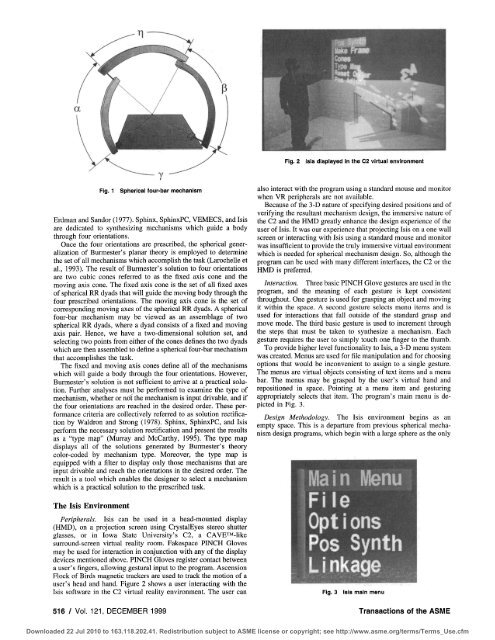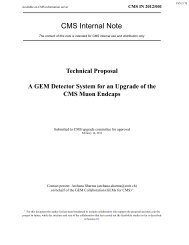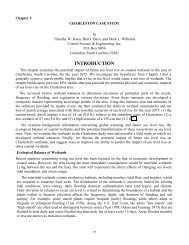Spherical Mechanism Synthesis in Virtual Reality - Florida Institute ...
Spherical Mechanism Synthesis in Virtual Reality - Florida Institute ...
Spherical Mechanism Synthesis in Virtual Reality - Florida Institute ...
You also want an ePaper? Increase the reach of your titles
YUMPU automatically turns print PDFs into web optimized ePapers that Google loves.
Fig. 1 <strong>Spherical</strong> four-bar mechanism<br />
Erdman and Sandor (1977). Sph<strong>in</strong>x, Sph<strong>in</strong>xPC, VEMECS, and Isis<br />
are dedicated to synthesiz<strong>in</strong>g mechanisms which guide a body<br />
through four orientations.<br />
Once the four orientations are prescribed, the spherical generalization<br />
of Burmester's planar theory is employed to determ<strong>in</strong>e<br />
the set of all mechanisms which accomplish the task (Larochelle et<br />
al., 1993). The result of Burmester's solution to four orientations<br />
are two cubic cones referred to as the fixed axis cone and the<br />
mov<strong>in</strong>g axis cone. The fixed axis cone is the set of all fixed axes<br />
of spherical RR dyads that will guide the mov<strong>in</strong>g body through the<br />
four prescribed orientations. The mov<strong>in</strong>g axis cone is the set of<br />
correspond<strong>in</strong>g mov<strong>in</strong>g axes of the spherical RR dyads. A spherical<br />
four-bar mechanism may be viewed as an assemblage of two<br />
spherical RR dyads, where a dyad consists of a fixed and mov<strong>in</strong>g<br />
axis pair. Hence, we have a two-dimensional solution set, and<br />
select<strong>in</strong>g two po<strong>in</strong>ts from either of the cones def<strong>in</strong>es the two dyads<br />
which are then assembled to def<strong>in</strong>e a spherical four-bar mechanism<br />
that accomplishes the task.<br />
The fixed and mov<strong>in</strong>g axis cones def<strong>in</strong>e all of the mechanisms<br />
which will guide a body through the four orientations. However,<br />
Burmester's solution is not sufficient to arrive at a practical solution.<br />
Further analyses must be perforrhed tq exam<strong>in</strong>e the type of<br />
mechanism, whether or not the mechanism is <strong>in</strong>put drivable, and if<br />
the four orientations are reached <strong>in</strong> the desired order. These performance<br />
criteria are collectively referred to as solution rectification<br />
by Waldron and Strong (1978). Sph<strong>in</strong>x, Sph<strong>in</strong>xPC, and Isis<br />
perform the necessary solution rectification and present the results<br />
as a "type map" (Murray and McCarthy, 1995). The type map<br />
displays all of the solutions generated by Burmester's theory<br />
color-coded by mechanism type. Moreover, the type map is<br />
equipped with a filter to display only those mechanisms that are<br />
<strong>in</strong>put drivable and reach the orientations <strong>in</strong> the desired order. The<br />
result is a tool which enables the designer to select a mechanism<br />
which is a practical solution to the prescribed task.<br />
The Isis Environment<br />
Peripherals. Isis can be used <strong>in</strong> a head-mounted display<br />
(HMD), on a projection screen us<strong>in</strong>g CrystalEyes stereo shutter<br />
glasses, or <strong>in</strong> Iowa State University's C2, a CAVE''^"-like<br />
surround-screen virtual reality room. Fakespace PINCH Gloves<br />
may be used for <strong>in</strong>teraction <strong>in</strong> conjunction with any of the display<br />
devices mentioned above. PINCH Gloves register contact between<br />
a user's f<strong>in</strong>gers, allow<strong>in</strong>g gestural <strong>in</strong>put to the program. Ascension<br />
Flock of Birds magnetic trackers are used to track the motion of a<br />
user's head and hand. Figure 2 shows a user <strong>in</strong>teract<strong>in</strong>g with the<br />
Isis software <strong>in</strong> the C2 virtual reality environment. The user can<br />
Fig. 2 Isis displayed In the C2 virtual environment<br />
also <strong>in</strong>teract with the program us<strong>in</strong>g a standard mouse and monitor<br />
when VR peripherals are not available.<br />
Because of the 3-D nature of specify<strong>in</strong>g desired positions and of<br />
verify<strong>in</strong>g the resultant mechanism design, the immersive nature of<br />
the C2 and the HMD greatly enhance the design experience of the<br />
user of Isis. It was our experience that project<strong>in</strong>g Isis on a one wall<br />
screen or <strong>in</strong>teract<strong>in</strong>g with Isis us<strong>in</strong>g a standard mouse and monitor<br />
was <strong>in</strong>sufficient to provide the truly immersive virtual environment<br />
which is needed for spherical mechanism design. So, although the<br />
program can be used with many different <strong>in</strong>terfaces, the C2 or the<br />
HMD is preferred.<br />
Interaction. Three basic PINCH Glove gestures are used <strong>in</strong> the<br />
program, and the mean<strong>in</strong>g of each gesture is kept consistent<br />
throughout. One gesture is used for grasp<strong>in</strong>g an object and mov<strong>in</strong>g<br />
it with<strong>in</strong> the space. A second gesture selects menu items and is<br />
used for <strong>in</strong>teractions that fall outside of the standard grasp and<br />
move mode. The third basic gesture is used to <strong>in</strong>crement through<br />
the steps that must be taken to synthesize a mechanism. Each<br />
gesture requires the user to simply touch one f<strong>in</strong>ger to the thumb.<br />
To provide higher level functionality to Isis, a 3-D menu system<br />
was created. Menus are used for file manipulation and for choos<strong>in</strong>g<br />
options that would be <strong>in</strong>convenient to assign to a s<strong>in</strong>gle gesture.<br />
The menus are virtual objects consist<strong>in</strong>g of text items and a menu<br />
bar. The menus may be grasped by the user's virtual hand and<br />
repositioned <strong>in</strong> space. Po<strong>in</strong>t<strong>in</strong>g at a menu item and gestur<strong>in</strong>g<br />
appropriately selects that item. The program's ma<strong>in</strong> menu is depicted<br />
<strong>in</strong> Fig. 3.<br />
Design Methodology. The Isis environment beg<strong>in</strong>s as an<br />
empty space. This is a departure from previous spherical mechanism<br />
design programs, which beg<strong>in</strong> with a large sphere as the only<br />
la<strong>in</strong> ienu<br />
F m<br />
m<br />
I le<br />
Opt i ons<br />
Pos Synth<br />
L i nkaae<br />
Fig. 3 Isis ma<strong>in</strong> menu<br />
516 / Vol. 121, DECEMBER 1999 Transactions of the ASME<br />
Downloaded 22 Jul 2010 to 163.118.202.41. Redistribution subject to ASME license or copyright; see http://www.asme.org/terms/Terms_Use.cfm
















